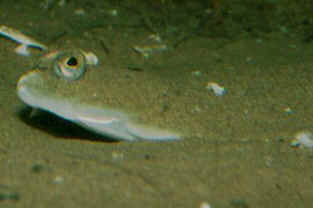Limanda limanda - Dab
Phylum: Chordata - Class: Actinopterygii - Order: Pleuronectiformes - Family: Pleuronectidae

The dab in this picture has partly buried itself in sand, so that you cannot see easily where the sea bed finishes and the fish starts: a useful defence strategy for a relatively small fish.
Dabs are often caught by anglers fishing inshore waters. They are good to eat, and on light tackle they can give quite good sport. These flatfish are instantly recognisable by a very strongly curved lateral line that rises over the pectoral fin on the 'eyed' side of the fish, a rough skin texture and a mass of darker speckles on the sandy-brown background. The underside is white.
A dab can grow up to 35cm (14 inches) long, reaching maturity when two or three years old and around 15cm long.
The Welsh rod-caught record, caught in 1936 near Port Talbot in South Wales, weighed 3lb 9oz (approx. 1.6kg).
Excited at the prospect of flyfishing? So are we, and we're pretty sure you would find the Winding River Mystery trilogy of action-packed thrillers gripping reading too. Dead Drift, Dead Cert, and Dead End are Pat O'Reilly's latest river-and-flyfishing based novels, and now they are available in ebook format. Full details on our website here...
Buy each book for just £4.96 on Amazon...
Please Help Us: If you have found this information interesting and useful, please consider helping to keep First Nature online by making a small donation towards the web hosting and internet costs.
Any donations over and above the essential running costs will help support the conservation work of Plantlife, the Rivers Trust and charitable botanic gardens - as do author royalties and publisher proceeds from books by Pat and Sue.
